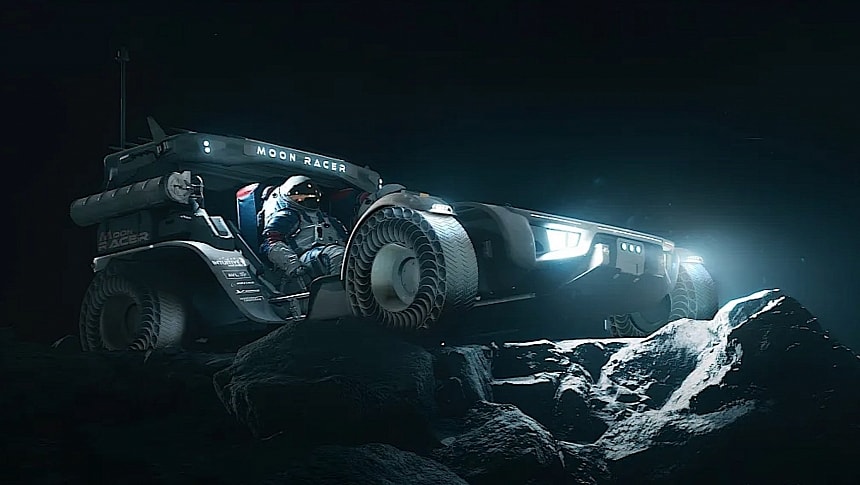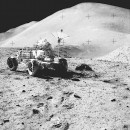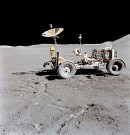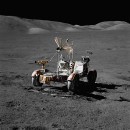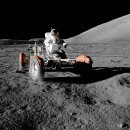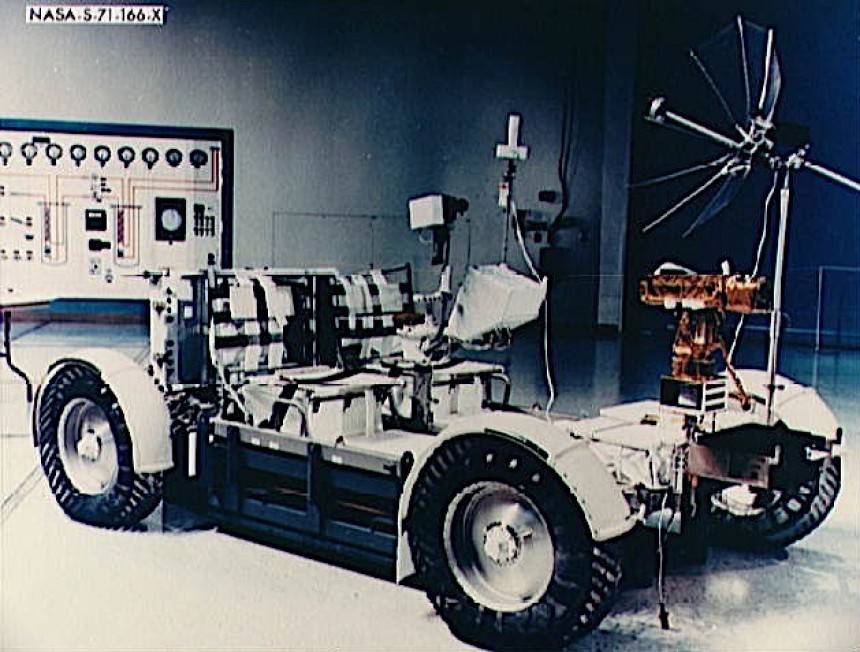Generally speaking, planetary rovers, be they meant for remote use or to carry people, are not pretty things. And they don't have to be, because no one will ever admire their looks, but rather value their skills. And yet the crew-rated Moon rover a company called Intuitive Machines is making looks like a proper, streamlined, and potent off-road race car.
Humanity has made over the years a number of remote-controlled rovers, but only one that was used as a proper vehicle by human beings.. We call it the Lunar Roving Vehicle (LRV) and it was a tool used by the people of the Apollo Moon exploration program to go about their business on the Moon.
The LRV was a pretty ugly-looking thing. It was nothing more than a chassis on wheels with some rudimentary seats bolted on, a quarter of nasty-looking wheels, and a large antenna installed up front that looked like an umbrella for heat-stricken demoiselles.
Boeing made the thing, and despite looking like that, it did what it was supposed to do: give astronauts a longer range to their research – it covered in all 22.30 miles (35.89 km) of the lunar surface, which was a hell of a lot better than the flimsy distances astronauts could reach on foot.
Now that the Artemis program is up on its feet, NASA plans to make rovers a common sight on the Moon once more. The agency calls the new one the Lunar Terrain Vehicle (LTV), and it just announced this week the three companies who will have a shot at making it.
The trio of businesses is made up of Lunar Outpost, Intuitive Machines, and Venturi Astrolab, each of them leading an assortment of other companies that are more or less giants in their respective fields. Lunar Outpost, for instance, works with Lockheed Martin, General Motors, and Goodyear, among others, and Venturi Astrolab is in cahoots with Axiom Space and Odyssey Space Research.
But we're here to talk about what Intuitive Machines has to offer for the NASA LTV project. The company is a name that's been in the news a lot lately, for the simple reason it recently became the first and to date only U.S.-based private company to land something on the Moon. That would be the Nova-C class lander called Odysseus.
For the LTV project the company partnered with a series of industry greats. The list of partners includes AVL, Boeing, Michelin, and Northrop Grumman, and each of them will contribute a lot to creating a rover called Moon Reusable Autonomous Crewed Exploration Rover (RACER).
RACER will have to be just as capable as all the others targeting a NASA contract. And that's natural, given how the rovers will be built to spec.
As per the space agency's requirements, the vehicle will have to be able to operate in the extreme temperatures on the Moon, and should be capable of carrying up to 500 kg (1,100 pounds) of cargo, including two fully suited astronauts. Cargo space and a robotic arm are to be included.
To be powered by an electric powertrain whose exact nature is yet to be determined, the LTV will feature a navigation console, cameras and sensors, and even headlights. It will have to be equipped with controls for humans to operate, as well as autonomous technologies that will make it usable even when crews are not on the surface of the Moon.
Intuitive Machine's RACER LTV will have all of that, of course, thanks to the combined powers of the participating companies.
The rover itself will be designed and built by Boeing, which is also tasked with mission planning and the operation of the RACER. The thing will move along on the surface of the Moon thanks to Michelin tires, which are yet to be detailed.
The power system for the rover will be made by Northrop Grumman, while the electric drivetrain, as well as the steering and suspension, are the responsibility of AVL.
Finally, Intuitive Machines itself will handle lead systems integration, spacecraft design, energy management, avionics, autonomous navigation, sensors, controls, mission planning, and operations. The private space company also took it upon itself to deliver the rover to the Moon, using an updated version of the lander already on site called Nova-D.
Although technically speaking all three competing LTV designs will be just as capable, the RACER stands out through its design. Although at the moment there is only one rendering of the thing, the one used as the main photo of this piece, it is clearly the most exciting-looking one, a vehicle that could easily be mistaken for a Moon racer (and guess what, that's exactly what's written on it).
NASA is potentially spending $4.6 billion on all three designs. The winner will be selected at least one year from now, and it will have to validate the design right up there on the Moon in a mission that should predate the planned 2029 Artemis V flight.
The LRV was a pretty ugly-looking thing. It was nothing more than a chassis on wheels with some rudimentary seats bolted on, a quarter of nasty-looking wheels, and a large antenna installed up front that looked like an umbrella for heat-stricken demoiselles.
Boeing made the thing, and despite looking like that, it did what it was supposed to do: give astronauts a longer range to their research – it covered in all 22.30 miles (35.89 km) of the lunar surface, which was a hell of a lot better than the flimsy distances astronauts could reach on foot.
Now that the Artemis program is up on its feet, NASA plans to make rovers a common sight on the Moon once more. The agency calls the new one the Lunar Terrain Vehicle (LTV), and it just announced this week the three companies who will have a shot at making it.
The trio of businesses is made up of Lunar Outpost, Intuitive Machines, and Venturi Astrolab, each of them leading an assortment of other companies that are more or less giants in their respective fields. Lunar Outpost, for instance, works with Lockheed Martin, General Motors, and Goodyear, among others, and Venturi Astrolab is in cahoots with Axiom Space and Odyssey Space Research.
But we're here to talk about what Intuitive Machines has to offer for the NASA LTV project. The company is a name that's been in the news a lot lately, for the simple reason it recently became the first and to date only U.S.-based private company to land something on the Moon. That would be the Nova-C class lander called Odysseus.
RACER will have to be just as capable as all the others targeting a NASA contract. And that's natural, given how the rovers will be built to spec.
As per the space agency's requirements, the vehicle will have to be able to operate in the extreme temperatures on the Moon, and should be capable of carrying up to 500 kg (1,100 pounds) of cargo, including two fully suited astronauts. Cargo space and a robotic arm are to be included.
To be powered by an electric powertrain whose exact nature is yet to be determined, the LTV will feature a navigation console, cameras and sensors, and even headlights. It will have to be equipped with controls for humans to operate, as well as autonomous technologies that will make it usable even when crews are not on the surface of the Moon.
Intuitive Machine's RACER LTV will have all of that, of course, thanks to the combined powers of the participating companies.
The rover itself will be designed and built by Boeing, which is also tasked with mission planning and the operation of the RACER. The thing will move along on the surface of the Moon thanks to Michelin tires, which are yet to be detailed.
Finally, Intuitive Machines itself will handle lead systems integration, spacecraft design, energy management, avionics, autonomous navigation, sensors, controls, mission planning, and operations. The private space company also took it upon itself to deliver the rover to the Moon, using an updated version of the lander already on site called Nova-D.
Although technically speaking all three competing LTV designs will be just as capable, the RACER stands out through its design. Although at the moment there is only one rendering of the thing, the one used as the main photo of this piece, it is clearly the most exciting-looking one, a vehicle that could easily be mistaken for a Moon racer (and guess what, that's exactly what's written on it).
NASA is potentially spending $4.6 billion on all three designs. The winner will be selected at least one year from now, and it will have to validate the design right up there on the Moon in a mission that should predate the planned 2029 Artemis V flight.
